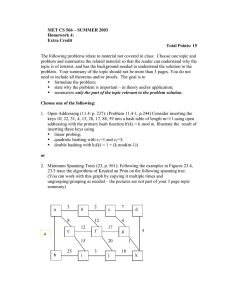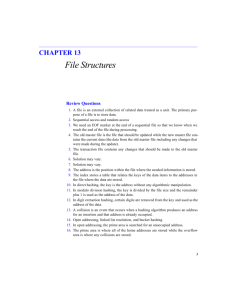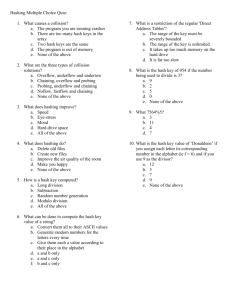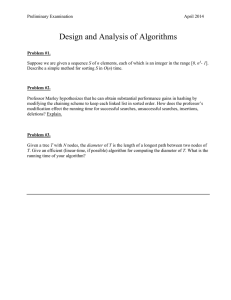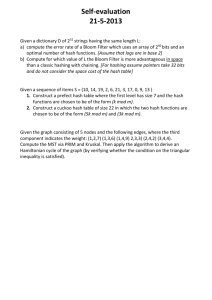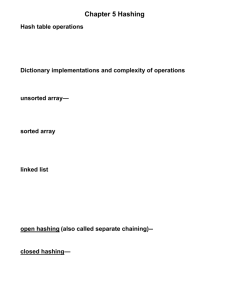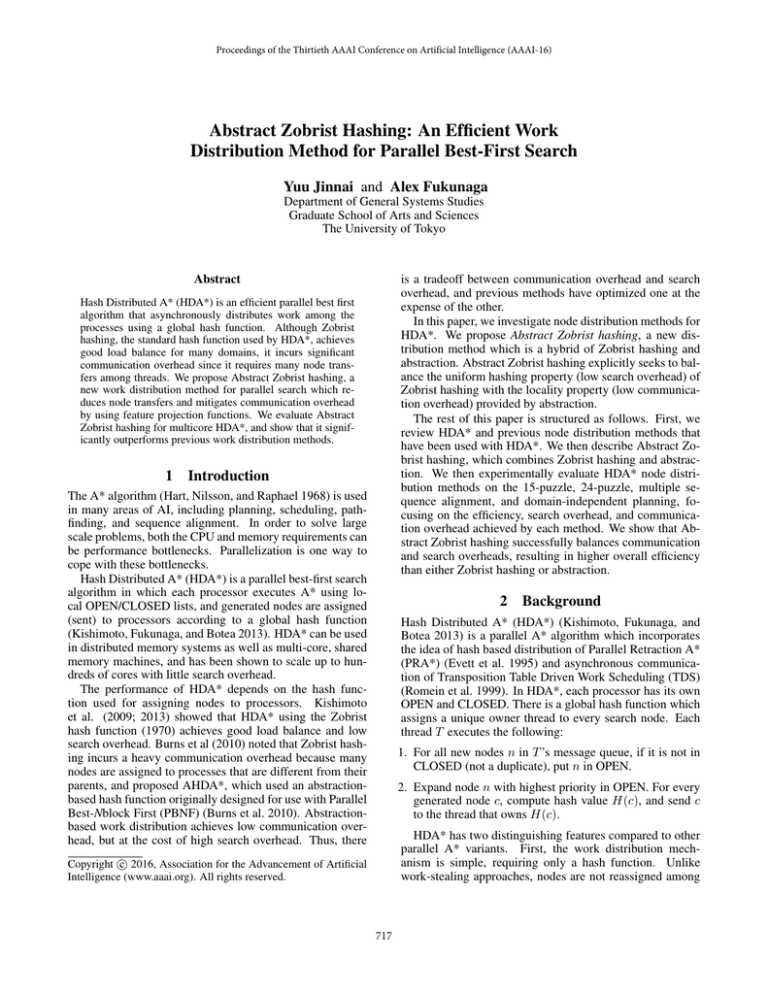
Proceedings of the Thirtieth AAAI Conference on Artificial Intelligence (AAAI-16)
Abstract Zobrist Hashing: An Efficient Work
Distribution Method for Parallel Best-First Search
Yuu Jinnai and Alex Fukunaga
Department of General Systems Studies
Graduate School of Arts and Sciences
The University of Tokyo
is a tradeoff between communication overhead and search
overhead, and previous methods have optimized one at the
expense of the other.
In this paper, we investigate node distribution methods for
HDA*. We propose Abstract Zobrist hashing, a new distribution method which is a hybrid of Zobrist hashing and
abstraction. Abstract Zobrist hashing explicitly seeks to balance the uniform hashing property (low search overhead) of
Zobrist hashing with the locality property (low communication overhead) provided by abstraction.
The rest of this paper is structured as follows. First, we
review HDA* and previous node distribution methods that
have been used with HDA*. We then describe Abstract Zobrist hashing, which combines Zobrist hashing and abstraction. We then experimentally evaluate HDA* node distribution methods on the 15-puzzle, 24-puzzle, multiple sequence alignment, and domain-independent planning, focusing on the efficiency, search overhead, and communication overhead achieved by each method. We show that Abstract Zobrist hashing successfully balances communication
and search overheads, resulting in higher overall efficiency
than either Zobrist hashing or abstraction.
Abstract
Hash Distributed A* (HDA*) is an efficient parallel best first
algorithm that asynchronously distributes work among the
processes using a global hash function. Although Zobrist
hashing, the standard hash function used by HDA*, achieves
good load balance for many domains, it incurs significant
communication overhead since it requires many node transfers among threads. We propose Abstract Zobrist hashing, a
new work distribution method for parallel search which reduces node transfers and mitigates communication overhead
by using feature projection functions. We evaluate Abstract
Zobrist hashing for multicore HDA*, and show that it significantly outperforms previous work distribution methods.
1
Introduction
The A* algorithm (Hart, Nilsson, and Raphael 1968) is used
in many areas of AI, including planning, scheduling, pathfinding, and sequence alignment. In order to solve large
scale problems, both the CPU and memory requirements can
be performance bottlenecks. Parallelization is one way to
cope with these bottlenecks.
Hash Distributed A* (HDA*) is a parallel best-first search
algorithm in which each processor executes A* using local OPEN/CLOSED lists, and generated nodes are assigned
(sent) to processors according to a global hash function
(Kishimoto, Fukunaga, and Botea 2013). HDA* can be used
in distributed memory systems as well as multi-core, shared
memory machines, and has been shown to scale up to hundreds of cores with little search overhead.
The performance of HDA* depends on the hash function used for assigning nodes to processors. Kishimoto
et al. (2009; 2013) showed that HDA* using the Zobrist
hash function (1970) achieves good load balance and low
search overhead. Burns et al (2010) noted that Zobrist hashing incurs a heavy communication overhead because many
nodes are assigned to processes that are different from their
parents, and proposed AHDA*, which used an abstractionbased hash function originally designed for use with Parallel
Best-Nblock First (PBNF) (Burns et al. 2010). Abstractionbased work distribution achieves low communication overhead, but at the cost of high search overhead. Thus, there
2
Background
Hash Distributed A* (HDA*) (Kishimoto, Fukunaga, and
Botea 2013) is a parallel A* algorithm which incorporates
the idea of hash based distribution of Parallel Retraction A*
(PRA*) (Evett et al. 1995) and asynchronous communication of Transposition Table Driven Work Scheduling (TDS)
(Romein et al. 1999). In HDA*, each processor has its own
OPEN and CLOSED. There is a global hash function which
assigns a unique owner thread to every search node. Each
thread T executes the following:
1. For all new nodes n in T ’s message queue, if it is not in
CLOSED (not a duplicate), put n in OPEN.
2. Expand node n with highest priority in OPEN. For every
generated node c, compute hash value H(c), and send c
to the thread that owns H(c).
HDA* has two distinguishing features compared to other
parallel A* variants. First, the work distribution mechanism is simple, requiring only a hash function. Unlike
work-stealing approaches, nodes are not reassigned among
c 2016, Association for the Advancement of Artificial
Copyright Intelligence (www.aaai.org). All rights reserved.
717
threads. Second, there is little coordination overhead because HDA* communicates asynchronously, and locks for
an access to shared OPEN/CLOSED are not required because each thread has its own local OPEN/CLOSED. However, contention for the memory bus, which can be considered a form of coordination overhead on multicore machines, can have a significant impact on performance (Kishimoto, Fukunaga, and Botea 2013).
2.1
1
00100101
4
3
7
1
5
8
2
6
2 t2=3
10001100
10101110
t3=4
00000111
3
Parallel Overheads in HDA*
State
Although an ideal parallel best-first search algorithm would
achieve a N-fold speedup on N threads, there are several parallel overheads which can prevent HDA* and other parallel
search algorithms from achieving perfect linear speedup.
Communication Overhead (CO): We define communication overhead as the ratio of nodes transferred to other
sent to other threads
threads: CO := # nodes
. CO is detrimental
# nodes generated
to performance because of delays due to message transfers,
as well as access to data structures such as message queues.
HDA* incurs communication overhead when transferring a
node from the thread where it is generated to its owner according to the hash function. In general, CO increases with
the number of threads. If nodes are assigned randomly to the
1
threads, CO will be proportional to 1 − #thread
.
Search Overhead (SO): Parallel search usually expands
more nodes than sequential A*. In this paper we define
# nodes expanded in parallel
search overhead as SO := #nodes
expanded in sequential search − 1.
In parallel search, SO can arise due to inefficient
load balance.
We define load balance as LB :=
Max # nodes assigned to a thread
Avg. # nodes assigned to a thread .
If load balance is poor, a thread which is assigned more
nodes than others will become a bottleneck – other threads
spend their time expanding less promising nodes, resulting
in search overhead. In HDA*, the load balance is determined
by the quality of the hash function – with a good hash function, HDA* has been shown to achieve very good load balance (Kishimoto, Fukunaga, and Botea 2013).
There is a fundamental trade-off between CO and SO. Increasing the amount of communication can reduce search
overhead at the cost of communication overhead, and vice
versa. The optimal tradeoff depends on the characteristic of the problem domain/instance, as well as the hardware/system on which HDA* is executed.
2.2
t1=2
Feature
Hash
Feature
State
Hash
(a) Zobrist
1
t1=2
1
S(t1)=1
01100010
4
3
7
1
5
8
2
6
2 t2=3
2
00101100
t3=4
3
State
S(t2)=1
Feature
01010001
S(t3)=2
3
00011111
Abstract
Feature
Abstract
Feature
Hash
State
Hash
(b) Abstract Zobrist
Figure 1: Comparison of calculation of Zobrist hash Z(s)
and Abstract Zobrist hash (AZH) value AZ(s) for the 8puzzle: State s is represented as s = (t1 , t2 , ..., t8 ), where
ti = 1, 2, ..., 9. The hash value of s is the result of xor’ing a
preinitialized random bit vector R[ti ] for each feature (tile)
ti . AZH incorporates an additional step which projects
features to abstract features (for each feature ti , look up
R[A(ti )] instead of R[ti ]).
The main strength of Zobrist hashing is that on domains
where the time to process each node (i.e., heuristic computation, node generation) is constant, then, with a hash function
which distributes nodes uniformly among threads, it is possible to achieve almost perfect load balance (however, as we
shall see later, load balance can be extremely poor if a bad
hash function is used). Another advantage to Zobrist hashing is that it can be incrementally computed very efficiently:
the hash value of a child node is computed by simply xor’ing
the parent node’s hash value with the feature hash of the difference between the parent and child states.
Zobrist hashing seeks to distribute nodes uniformly
among all threads, without any consideration of the neighborhood structure of the search space graph. As a consequence, communication overhead is high. Assume an
ideal implementation that assigns nodes uniformly among
threads. Every generated node is sent to another thread with
1
. Therefore, with 16 threads, > 90%
probability 1− #threads
of the nodes are sent to other threads, so communication
costs are incurred for the vast majority of node generations.
Figure 5e shows the CO of HDA* with Zobrist hashing
(ZHDA*) on the 24-puzzle. With 4 threads, 72% of the
nodes are transferred to another thread. The CO increases
to 92% when running on 16 threads. As a consequence,
efficiency of ZHDA* clearly decreases as the # of threads
Zobrist Hashing and Abstraction
Since the work distribution in HDA* is solely dependent on
a global hash function, the choice of the hash function is
crucial to its performance. Kishimoto et al. (2013) used
Zobrist hashing (1970), which is widely used in 2-player
games such as chess. Figure 1a illustrates the calculation
of Zobrist hashing on the 8 Puzzle. The Zobrist hash value
of a state s, Z(s), is calculated as follows. For simplicity,
assume that s is represented as an array of n propositions,
s = (x0 , x1 , ..., xn ). Let R be a table containing preinitialized random bit strings.
Z(s) := R[x0 ] xor R[x1 ] xor · · · xor R[xn ]
718
increases (Figure 5b). Since Zobrist hashing achieves good
load balance, SO does not increase as the # of threads is increased (Figure 5e). Thus, in this case, CO is the most likely
cause of efficiency degradation.
In order to minimize communication overhead in HDA*,
Burns et al (2010) proposed AHDA*, which uses abstraction based node assignment. AHDA* applies the state space
partitioning technique used in PBNF (Burns et al. 2010),
which in turn is based on Parallel Structured Duplicate
Detection (PSDD) (Zhou and Hansen 2007). Abstraction
projects nodes in the state space into abstract states, and
abstract states are assigned to processors using a modulus
operator. Thus, nodes that are projected to the same abstract
state are assigned to the same thread. If the abstraction function is defined so that children of node n are usually in the
same abstract state as n, then communication overhead is
minimized. The drawback of this method is that it focuses
solely on minimizing communication overhead, and there is
no mechanism for equalizing load balance, which can lead to
high search overhead. In fact, Figure 5e shows that abstraction has roughly 2-4 times higher search overhead compared
to Zobrist hash on the 24-puzzle.
3
2
2, 3
4
5
6
4, 5, 6
7
8
1
1, 7, 8
3
P0
P1
3
2
3
2
4
5
6
4
5
6
4
7
8
1
7
8
1
7
8
1
4
3
2
3
2
6
2
5
6
4
5
8
1
7
8
7
3
1
3
7
5
2, 3, 5
2
4, 6
6
5
2
3
5
4
6
4
6
8
1
7
8
1
1, 7, 8
3
5
2
4
8
6
7
1
Figure 2: Distribution of nodes according to Abstract Zobrist hashing on 2 threads, using a projection from a cell
to a row of the puzzle. States inside the lines are assigned
to the same processor because they share the same abstract
features.
features in the state, rather than a subset of features.1
By adjusting the size of the abstract feature, AZH allows
explicit tuning of the trade-off between communication and
search overheads (CO vs SO). In general, larger abstract features result in smaller CO and large SO, while smaller abstract features result in larger CO and smaller SO – standard
Zobrist hashing is a special case of AZH with abstract feature size 1.
AZH is simple to implement, requiring only an additional
projection per feature compared to Zobrist hashing, and we
can precompute this projection at initialization. Thus, there
is no additional runtime overhead per node during search.
Abstract Zobrist Hashing
Abstract Zobrist hashing (AZH) is a hybrid hashing strategy
which incorporating the strengths of both Zobrist hashing
and abstraction. AZH augments the Zobrist hashing framework with the idea of projection from abstraction. The AZH
value of a state, AZ(s) is:
AZ(s) := R[A(x0 )] xor R[A(x1 )] xor · · · xor R[A(xn )]
where A is a feature projection function, which is a manyto-one mapping from each raw feature to an abstract feature,
and R is a precomputed table defined for each abstract feature. Thus, AZH is a 2-level, hierarchical hash function,
where raw features are first projected to abstract features,
and Zobrist hashing is applied to the these abstract features.
Figure 1 illustrates the computation of AZH for the 8-puzzle,
and Figure 2 illustrates the distributions of nodes according
to AZH for a set of 8-puzzle states.
AZH seeks to combine the advantages of both abstraction and Zobrist hashing. Communication overhead is minimized by building abstract features that share the same
hash value (abstract features are analogous to how abstraction projects states to abstract states), and load balance is
achieved by applying Zobrist hashing to the abstract features
of each state.
Compared to Zobrist hashing, AZH incurs less communication overhead due to abstract feature-based hashing.
While Zobrist hashing assigns a hash value for each node independently, AZH assigns the same hash value for all nodes
which shares the same abstract features for all features, reducing the number of node transfers.
In contrast to abstraction-based node assignment, which
minimizes communications but does not optimize load balance and search overhead, AZH also seeks good load balance, because the node assignment takes into account all
4
Experiments
We evaluated the performance of the following HDA* variants on several standard benchmark domains with different
characteristics.
• AZHDA*: HDA* using Abstract Zobrist hashing
• ZHDA*: HDA* using Zobrist hashing
• AHDA*: HDA* using Abstraction based work distribution (Burns et al. 2010)
The experiments were run on an Intel Xeon E5-2650 v2 2.60
GHz CPU with 128 GB RAM, using up to 16 cores.
The 15-puzzle experiments in Section 4.1 are based on
the code by Burns et al (2010), which includes their implementations of HDA* (called “PHDA*” below), AHDA*,
and SafePBNF (we implemented 15-puzzle ZHDA* and
AZHDA* as an extension of their code).
1
To see why ignoring features can lead to poor load balance: consider a blocksworld problem where the goal is on(a,b),
on(b,c), on(c,floor), and on(c,floor)=T in the initial state. With
a reasonable heuristic, almost all states generated will have
on(c,floor)=T. However, if the work distribution function distributes states based only on the feature on(c,floor), then almost
all states will be assigned to the same processor, resulting in disastrous load balance.
719
0.7
0.6
P16
P8
0.5
P4
(a) 15 Zobrist
(b) 15 AZ
(c) 24 Zobrist
SO
0.4
(d) 24 AZ
0.3
0.2
Figure 3: The abstract features used by Abstract Zobrist
hashing for 15 and 24 puzzle.
A4
0.1
Z4
0
1
For the 24-puzzle, multiple sequence alignment (MSA),
and PDDL planning, we used our own implementation of
HDA*, using the Pthreads library, try lock for asynchronous
communication, and the Jemalloc memory allocator (Evans
2006). We implemented OPEN as a 2-level bucket for the
24-puzzle and planning (Burns et al. 2012), and a binary
heap for MSA (binary heap was faster for MSA).
4.1
A16
A8
Z8
1.05
Z16
1.1
b16
b8
b4
1.15
1.2
LB
1.25
1.3
1.35
1.4
1.45
Figure 4: Load balance (LB) and search overhead (SO)
on 100 instances of the 15-Puzzle for 4/8/16 threads. A:
AZHDA*, Z: ZHDA*, b: AHDA*, P: PHDA*, e.g., Z8 is
the LB and SO for Zobrist hashing on 8 threads. 2-D error
bars show standard error of the mean for both SO and LB.
15 Puzzle
Figure 5a shows the efficiency of each method. PHDA*
performed extremely poorly compared to all other HDA*
variants and SafePBNF. The reason is clear from Figure
5d, which shows the communication and search overheads.
PHDA* has both extremely high search overhead and communication overhead compared to all other methods. This
shows that the hash function used by PHDA* is not wellsuited as a work distribution function.
AHDA* had the lowest CO among HDA* variants (Figure 5d), and significantly outperformed PHDA*. However,
AHDA* has worse LB than ZHDA* (Figure 4), resulting in
higher SO. For the 15-puzzle, this tradeoff is not favorable
for AHDA*, and Figures 5a-4 show that ZHDA*, which has
significantly better LB and SO, outperforms AHDA*.
According to Figure 5a, SafePBNF outperforms AHDA*,
and is comparable to ZHDA* on the 15-puzzle. Although
our definition of communication overhead does not apply to
SafePBNF, SO for SafePBNF was comparable to AHDA*,
0.11/0.17/0.24 on 4/8/16 threads.
AZHDA* significantly outperformed ZHDA*, AHDA*,
and SafePBNF. As shown in Figure 5d, although AZHDA*
had higher SO than ZHDA* and higher CO than AHDA*, it
achieved a balance between these overheads which resulted
in high overall efficiency. The tradeoff between CO and SO
depends on each domain and instance. By tuning the size of
the abstract feature, we can choose a suitable tradeoff.
We solved 100 randomly generated instances with solvers
using the Manhattan distance heuristic. The average runtime of sequential A* solving these instances was 52.3 seconds. In addition to AZHDA*, ZHDA*, and AHDA*, we
also evaluated SafePBNF (Burns et al. 2010) and the configuration of HDA* which was evaluated in (Burns et al. 2010),
which we call PHDA* in this paper.
PHDA* uses a perfect hashing scheme by (Korf and
Schultze 2005), which maps permutations (tile positions)
to lexicographic indices (thread IDs). A perfect hashing
scheme computes a unique mapping from permutations (abstract state encoding) to lexicographic indices (thread ID).
While this encoding is effective for its original purpose of efficient representation of states for external-memory search,
it was not designed for the purpose of work distribution.
In the original experiments in (Burns et al. 2010), all of
the 15-puzzle parallel A* variants used a binary heap implementation for OPEN. However, it has been shown that
for the 15-Puzzle, 2-level bucket OPEN is more than twice
as fast as with a binary heap (Burns et al. 2012). Thus, we
evaluated with both configurations, binary heap and 2-level
bucket. We show results using 2-level bucket OPEN, as it
was faster for every algorithm and using binary heap OPEN
did not change the results qualitatively.
The features used by Zobrist hashing in ZHDA* are the
position of each tile i. The projections we used for Abstract
Zobrist hashing in AZHDA* are shown in Figure 3. The abstraction used by AHDA* ignores the positions of all tiles
except tiles 1,2, and 3 (we tried (1) ignoring all tiles except tiles 1,2, and 3, (2) ignoring all tiles except tiles 1,2,3,
and 4, (3) mapping cells to rows, and (5) mapping cells to
the blocks which AZHDA* use for a feature projection, and
chose (1) because it performed the best).
First, as discussed in Section 2, high search overhead is
correlated with load balance. Figure 4, which shows the relationship between load balance and search overhead, indicates a very strong correlation between high load imbalance
and search overhead.
4.2
24 Puzzle
We generated a set of 100 random instances that could be
solved by A* within 1000 seconds. We chose the hardest
instances solvable given the memory limitation (128GB).
The average runtime of sequential A* on these instances
was 219.0 seconds. The average solution lengths of our
24-puzzle instances was 92.9 (the average solution length
in (Korf and Felner 2002) was 100.8). We used a disjoint
pattern database heuristic (Korf and Felner 2002). Figure 3
shows the feature projections we used for 24 Puzzle. The
abstraction used by AHDA* ignores the numbers on all of
720
AZHDA*
ZHDA*
SafePBNF
AHDA*
PHDA*
0.9
Efficiency
0.6
0.8
0.4
0.7
0.2
AZHDA*
AHDA*
ZHDA*
0.6
0
4
6
8
10
12
14
0.5
16
4
6
8
12
14
16
(a) 15 Puzzle: Efficiency
P8
0.3
P16
0.5
b8
SO
SO
b4
0
0.2
b16
b4
0.15
b16
0.1
0.1
A16
A8
A4
0.2
Z8 Z16
CO
0.6
0.8
A4
0.05
Z4
0.4
8
1
0
Z4
A16
Z8 Z16
A8
0
(d) 15 Puzzle: CO vs. SO
0.2
0.4
CO
10
12
14
16
(c) MSA: Efficiency
0.25
P4
0.4
b8
6
#thread
0.35
0.6
0.2
4
(b) 24 Puzzle: Efficiency
0.7
0.3
AZHDA*
ZHDA*
AHDA*
HWD
#thread
#thread
0
10
1
0.95
0.9
0.85
0.8
0.75
0.7
0.65
0.6
0.55
0.5
0.5
0.45
0.4
0.35
0.3
0.25
0.2
0.15
0.1
0.05
0
b16
SO
Efficiency
0.8
1
Efficiency
1
0.6
(e) 24 Puzzle: CO vs. SO
0.8
1
b8
b4
H16
H8
A16
A8
H4
A4
0
0.2
0.4
CO
Z8 Z16
Z4
0.6
0.8
1
(f) MSA: CO vs. SO
Figure 5: Efficiency, Communication Overhead (CO), and Search Overhead (SO) for 15-puzzle (100 instances), 24-puzzle (100
instances), and MSA (60 instances) on 4/8/16 threads. OPEN is implemented using a 2-level bucket for sliding-tiles. OPEN for
MSA is implemented using a binary heap. In the CO vs SO plot, A: AZHDA*, Z: ZHDA*, b: AHDA*, P: PHDA*, H: HWD,
e.g., Z8 is the CO and SO for Zobrist hashing on 8 threads. Error bars show standard error of the mean.
length l share a same hash value. We grouped up l positions
in row into a abstract feature for Abstract Zobrist hashing.
The abstraction used by AHDA* only considers the position
of the longest sequence and ignores the others. We chose
this abstraction as it performed the best compared to (1)
considering only the longest sequence, (2) the two longest
sequences, and (3) the three longest sequences. We also
evaluated the performance of Hyperplane Work Distribution (HWD) (Kobayashi, Kishimoto, and Watanabe 2011).
ZHDA* suffers from node duplication in non-unit cost domains such as MSA. HWD seeks to reduce node duplication
by mapping the n-dimension grid to hyperplanes. We determined the plane thickness d using the tuning method shown
in (Kobayashi, Kishimoto, and Watanabe 2011) where λ =
0.003, which yielded the best performance among 0.0003,
0.003, 0.03, and 0.3.
the tiles except tiles 1,2,3,4, and 5 (we tried (1) ignoring all
tiles except tiles 1-5, (2) ignoring all tiles except tiles 1-6, (3)
ignoring all tiles except tiles 1-4, (4) mapping cells to rows,
and (5) mapping cells to the blocks which AZHDA* use for
a feature projection, and chose (1), the best performer).
Figure 5b shows the efficiency of each method. AZHDA*
outperformed ZHDA* and AHDA*, and Figure 5e suggests
that AZHDA* had smaller overall overheads. As on the 15puzzle, ZHDA* and AHDA* succeed in mitigating only one
of the overheads (SO or CO). AZHDA* outperformed both
methods as it had comparable SO to ZHDA* while its CO
was roughly equal to that of AHDA*.
4.3
Multiple Sequence Alignment (MSA)
Multiple Sequence Alignment is the problem to finding a
minimum-cost alignment of a set of DNA or amino acid sequences by inserting gaps in each sequence. MSA can be
solved by finding the min-cost path between corners in a ndimensional grid. We used 60 benchmark instances, consisting of 10 actual amino acids from BAliBASE 3.0 (Thompson et al. 2005), and 50 randomly generated amino acids.
Edge cost is based on the PAM250 matrix score with gap
penalty 8. Since there was no significant difference between
the behavior of HDA* among actual and random instances,
we report the average of all 60 instances. We used pairwise
sequence alignment heuristic (Korf et al. 2005).
We set the positions of each sequence to be the feature for
Zobrist hashing and Abstract Zobrist hashing. Thus, with n
sequences, nodes in the n-dimensional hypercube with edge
Figure 5c compares the efficiency of each method, and
Figure 5f shows the CO and SO. AZHDA* outperformed the
other methods. With 4 or 8 threads, AZHDA* had smaller
SO than ZHDA*. This is because like HWD, AZHDA*
reduced the amount of duplicated nodes in some domains
compared to ZHDA*. Our MSA solver expands 300,000
nodes/second, which is relatively slow compared to, e.g.,
our 24-puzzle solver, which expands 1,400,000 nodes/sec.
When node expansions are slow, the relative importance of
CO decreases, and SO has a more significant impact on performance in MSA than in the 15/24-Puzzles. Thus, AHDA*,
which incurs higher SO, did not perform well compared to
ZHDA*. HWD did not perform well, but it was designed for
721
0.2
large-scale, distributed search, and we observed HWD to be
more efficient on difficult instances than on easier instances
– it is included in this evaluation only to provide another
point of reference for evaluating ZHDA* and AZHDA*.
b
Cost-optimal PDDL Planning with
Automatically Generated Abstract Features
0.05
b
b
0
bb
A
-0.05
We implemented a domain independent planner which handles a subset of PDDL (STRIPS + action costs + types),
and uses A* with the pattern database (PDB) heuristic
used in (Edelkamp 2001). In the blocksworld domain,
our planner running single thread HDA* expanded 211,000
nodes/second, whereas Fast Downward (Helmert 2006) using the PDB heuristic expanded 232,000 nodes/sec. Thus,
although the heuristic function is not competitive with the
state-of-the-art, we believe this implementation is sufficient
as a platform for evaluating parallel efficiency and overheads
in domain-independent planning. We evaluated the HDA*
planner on 13 instances from the IPC benchmark. We chose
1 nontrivial instance from each domain which was solvable
by sequential A* with the PDB heuristic.
Unlike the hand-designed abstract features and abstractions used for the sliding tile puzzle and MSA, our AZHDA*
planner builds abstract features completely automatically –
we first analyze the domain to find atom groups, which are
often used for constructing PDBs (Edelkamp 2001). An
atom group is a set of mutually exclusive propositions which
exactly one will be true for each reachable state. We build
atom groups as in (Edelkamp and Helmert 1999), trying
to merge predicates in the order they are written in PDDL
file. Each atom group is partitioned into 2 abstract features
S1 and S2 , based on the atom group’s undirected transition
graph (nodes are propositions, edges are transitions), as follows: (1) assign the minimal degree node to S1 ; (2) add to
S1 the unassigned node which shares the most edges with
nodes in S1 ; (3) while |S1 | < n/2 repeat step (2); (4) assign all unassigned nodes to S2 . For AHDA*, we built abstractions using the greedy abstraction algorithm described
in (Zhou and Hansen 2006). The greedy abstraction algorithm adds one atom group to the abstract graph at a time,
choosing the atom group which minimizes the maximum
out-degree of the abstract graph, until the graph size (# of
nodes) reaches the threshold given by a parameter Nmax .
We set Nmax = 103 (we tried 102 , 103 , 104 and chose 103
because it performed best).
Table 1 shows the results for 8 threads. Although the efficiency differences are not as pronounced as in the 15/24puzzle and MSA, AZHDA* outperforms both ZHDA* and
AHDA* (higher average efficiency and lower total wallclock runtime for all problems). Figure 6 shows the CO
and SO. The overall trends are similar to the results for our
domain-specific solvers for the sliding tiles puzzles and the
MSA. AZHDA* has lower search overhead than AHDA*,
and lower communication overhead than ZHDA*.
Th greedy algorithm for generating abstract features is
simple, and more sophisticated methods are a direction for
future work. However, our results show that even this simple method is sufficient to generate abstract features that can
A
b
b
0.1
SO
4.4
b
0.15
b A
-0.1
A
b
A
Z
AA bA
A
A
Z
Z ZZZZZ
A
A bZ
AZ
Z
b
-0.15
0
0.1
0.2
0.3
0.4
0.5
0.6
0.7
0.8
0.9
1
CO
Figure 6: Planning: Communication Overhead (CO) vs.
Search Overhead (SO) on 8 threads. A: AZHDA*, Z:
ZHDA*, b: AHDA*.
reduce CO compared to ZHDA*, resulting in modest improvement on efficiency and the lowest total runtime.
5
Conclusions and Future Work
We investigated node distribution methods for HDA*, and
showed that previous methods suffered from high communication overhead (ZHDA*), high search overhead (AHDA*),
or both (PHDA*), which limited their efficiency. We proposed AZHDA*, which uses Abstract Zobrist hashing, a
new distribution method which combines the strengths of
both Zobrist hashing and abstraction. Our experimental results showed that AZHDA*, achieves a successful trade-off
between communication and search overheads, resulting in
better performance than previous work distribution methods.
While the abstract features for our domain-specific
sliding-tile and MSA solvers were designed by hand,
our preliminary results using automatically generated abstract features for domain-independent planning showed that
AZHDA* can achieve a favorable tradeoff between communication and search overheads using completely automatically generated abstract features.
Although our experiments were performed on a single
multicore processor because it is easier to perform controlled experiments on a single machine, HDA* has been
shown to scale on large-scale distributed memory systems
(Kishimoto, Fukunaga, and Botea 2013), and extending this
work to large-scale clusters is a direction for future work.
Since communication overhead becomes an increasingly
more serious problem as (a) the number of cores increases
and (b) the connection between cores becomes relatively
slower, reducing communication overhead will be increasingly important on large-scale systems.
The comparison with SafePBNF on the 15-Puzzle (Sec
4.1) indicates that ZHDA* and AZHDA* are competitive
with SafePBNF. However, evaluation of HDA* as a stateof-the-art multicore search algorithm is not the main goal of
this paper, and a full comparison of HDA* and SafePBNF is
an avenue for future work.
AZHDA* successfully combines the idea of feature hashing from HDA* and the idea of abstraction from PSDD
722
#thread=8
Airport9
Barman1-1
Blocks10-2
Elevators11-26
Floortile1-1
Freecell5
Gripper7
Logistics98-32
PipesNoTk14
Sokoban11-13
Transport08-14
Visitall11-7Half
Zenotravel8
Average
Total
A*
Time (sec)
156.59
30.32
234.27
142.66
254.74
141.74
77.23
25.44
231.50
129.66
85.89
10.13
26.52
118.97
1646.74
Expd
4902509
4719078
39226226
5329127
30523550
9142007
10101217
1837543
34862961
10048931
9830158
1952096
1330916
12600486
163806319
AZHDA*
Eff
CO
SO
0.799 0.480 -0.005
0.641 0.770
0.133
0.988 0.540
0.009
0.654 0.380
0.007
0.768 0.850 -0.032
0.774 0.650
0.000
0.766 0.720
0.001
0.758 0.460 -0.058
0.835 0.820 -0.002
0.893 0.630 -0.001
0.831 0.310 -0.041
0.873 0.880 -0.044
0.784 0.570 -0.045
0.797 0.620 -0.006
Time (sec)
282.29
ZHDA*
Eff
CO
0.808 0.560
0.707 0.960
0.932 0.890
0.601 0.850
0.806 0.900
0.751 0.890
0.743 0.880
0.628 0.880
0.883 0.860
0.874 0.820
0.694 0.870
0.867 0.890
0.661 0.890
0.766 0.857
Time (sec)
SO
-0.007
-0.002
0.011
-0.001
-0.046
-0.002
0.004
0.000
-0.000
-0.001
0.001
-0.041
-0.003
-0.007
298.92
AHDA*
Eff
CO
0.720 0.240
0.613 0.640
1.013 0.400
0.648 0.070
0.905 0.300
0.375 0.080
0.849 0.340
0.808 0.310
1.016 0.400
0.288 0.150
0.695 0.770
0.804 0.880
0.749 0.700
0.729 0.406
Time (sec)
SO
0.024
0.144
0.041
0.114
-0.018
0.100
0.003
-0.009
-0.102
0.172
0.024
-0.039
-0.006
0.034
341.73
Table 1: Performance of work distribution methods on PDDL planning (8 threads). Time: Walltime on sequential A*, Expd:
Node expansion on sequential A*, Eff: Efficiency relative to speedup, CO: Communication overhead, SO: Search overhead.
Kishimoto, A.; Fukunaga, A. S.; and Botea, A. 2009. Scalable, parallel best-first search for optimal sequential planning. In Proc. 19th International Conference on Automated
Planning and Scheduling (ICAPS), 201–208.
Kishimoto, A.; Fukunaga, A.; and Botea, A. 2013. Evaluation of a simple, scalable, parallel best-first search strategy.
Artificial Intelligence 195:222–248.
Kobayashi, Y.; Kishimoto, A.; and Watanabe, O. 2011.
Evaluations of Hash Distributed A* in optimal sequence
alignment. In Proc. 22nd International Joint Conference on
Artificial Intelligence (IJCAI), 584–590.
Korf, R. E., and Felner, A. 2002. Disjoint pattern database
heuristics. Artificial Intelligence 134(1):9–22.
Korf, R. E., and Schultze, P. 2005. Large-scale parallel
breadth-first search. In Proc. 20th National Conference on
Artificial Intelligence (AAAI), 1380–1385.
Korf, R. E.; Zhang, W.; Thayer, I.; and Hohwald, H. 2005.
Frontier search. Journal of the ACM (JACM) 52(5):715–748.
Romein, J. W.; Plaat, A.; Bal, H. E.; and Schaeffer, J. 1999.
Transposition table driven work scheduling in distributed
search. In Proc. 16th National Conference on Artificial Intelligence (AAAI), 725–731.
Thompson, J. D.; Koehl, P.; Ripp, R.; and Poch, O. 2005.
BAliBASE 3.0: Latest developments of the multiple sequence alignment benchmark. Proteins: Structure, Function
and Genetics (PROTEINS) 61(1):127–136.
Zhou, R., and Hansen, E. A. 2006. Domain-independent
structured duplicate detection. In Proc. 21st National Conference on Artificial Intelligence (AAAI), 1082–1087.
Zhou, R., and Hansen, E. A. 2007. Parallel structured duplicate detection. In Proc. 22nd AAAI Conference on Artificial
Intelligence (AAAI), 1217–1223.
Zobrist, A. L. 1970. A new hashing method with application for game playing. reprinted in International Computer
Chess Association Journal (ICCA) 13(2):69–73.
(Zhou and Hansen 2007) and PBNF. The success of
AZHDA* suggests that further combinations of ideas from
both lines of work may be fruitful. For example, structurebased parallel search (PSDD, PBNF) partitions the search
space into many blocks, and appear to be well-suited for domains with many distinct f-values, which necessitates a binary heap implementation of OPEN, so incorporating finegrained OPEN lists into HDA* is an avenue for future work.
Finally, Abstract Zobrist hashing is a general work distribution method which is not limited to HDA*. Applications
to other algorithms such as TDS (Romein et al. 1999) is an
interesting avenue for future work.
References
Burns, E. A.; Lemons, S.; Ruml, W.; and Zhou, R. 2010.
Best-first heuristic search for multicore machines. Journal
of Artificial Intelligence Research 39:689–743.
Burns, E. A.; Hatem, M.; Leighton, M. J.; and Ruml, W.
2012. Implementing fast heuristic search code. In Proc. 5th
Annual Symposium on Combinatorial Search, 25–32.
Edelkamp, S., and Helmert, M. 1999. Exhibiting knowledge
in planning problems to minimize state encoding length. In
European Conference on Planning (ECP), 135–147.
Edelkamp, S. 2001. Planning with pattern databases. In
European Conference on Planning (ECP), 13–24.
Evans, J. 2006. A scalable concurrent malloc (3) implementation for FreeBSD. In Proc. BSDCan Conference.
Evett, M.; Hendler, J.; Mahanti, A.; and Nau, D. 1995.
PRA*: Massively parallel heuristic search. Journal of Parallel and Distributed Computing 25(2):133–143.
Hart, P. E.; Nilsson, N. J.; and Raphael, B. 1968. A formal basis for the heuristic determination of minimum cost
paths. IEEE Transactions on Systems Science and Cybernetics 4(2):100–107.
Helmert, M. 2006. The Fast Downward planning system.
Journal of Artificial Intelligence Research 26:191–246.
723

